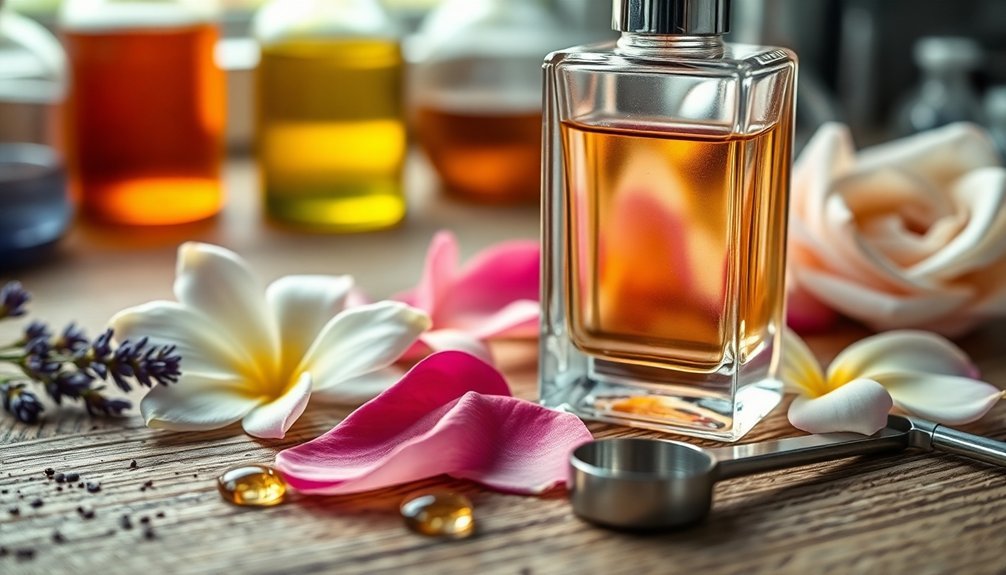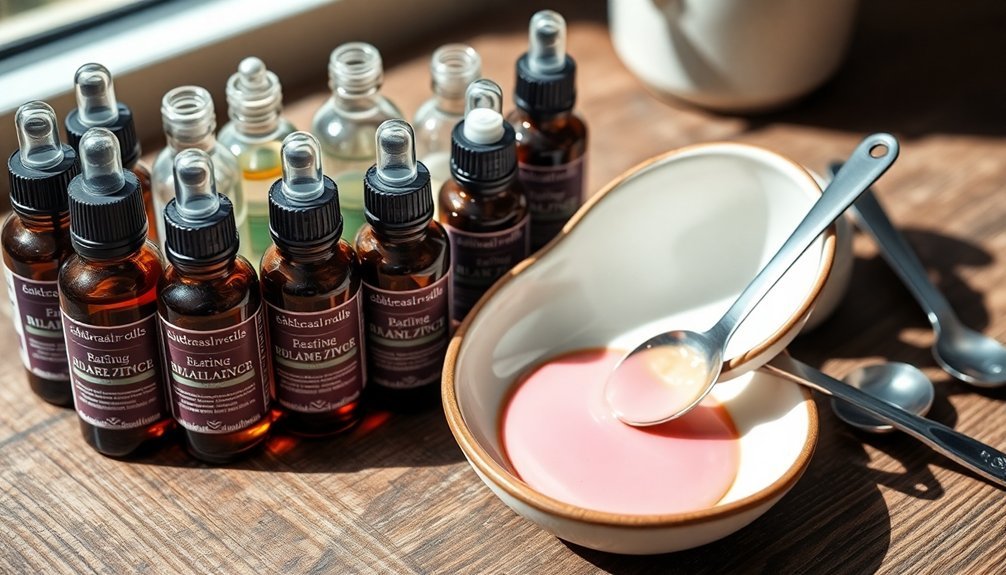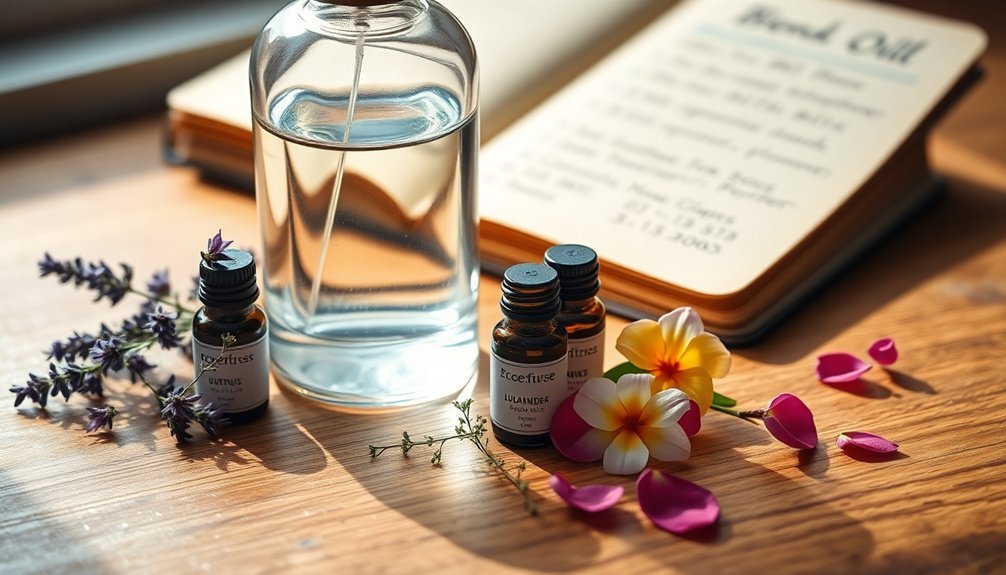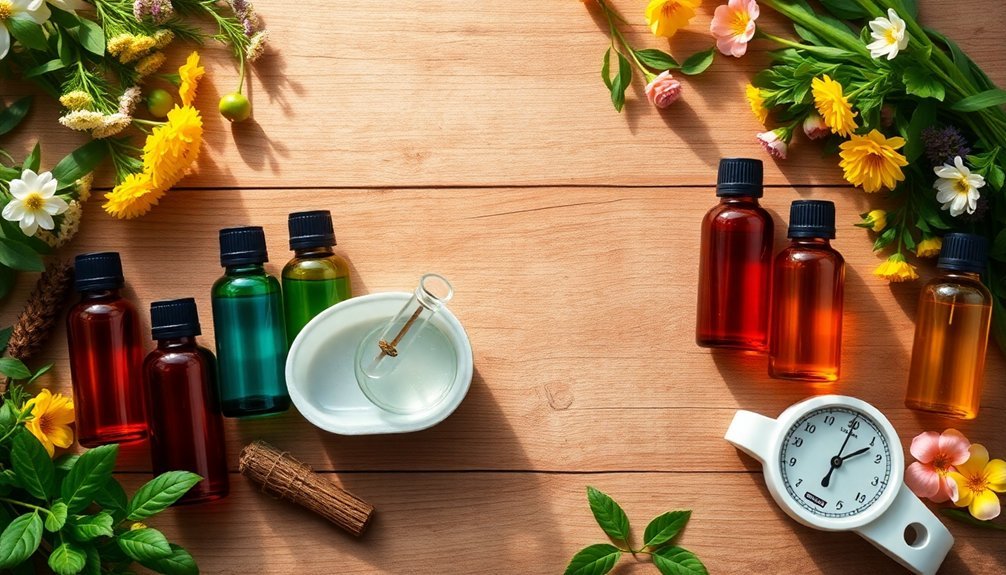For aromatherapy perfumes that actually work, you'll want to follow proven ratios like 3:2:1 (top:middle:base notes) for mood enhancement or 2:3:1 for relaxation blends. The 30-50-20 ratio serves as another reliable foundation, especially when using classic combinations like lavender, ylang-ylang, and cedarwood. Always dilute with carrier oils at 2.5% concentration for safe application. These basic formulas will put you on track, but mastering the nuances can transform your blending practice.
Understanding the Science Behind Perfume Note Ratios

When creating a perfume, understanding the science of note ratios forms the foundation of successful fragrance blending. The fragrance pyramid, developed by Jean Carles, shows how different notes interact and evolve on your skin over time.
You'll notice that top notes evaporate quickly within 15-30 minutes, while middle notes emerge and last for several hours. Base notes, with their low volatility, provide lasting power that can extend for days. This varying evaporation rate affects how you'll need to balance your blend ratios.
While common ratios like 1:1:1 or 3:2:1 exist, there's no strict rule you must follow. Instead, you'll want to take into account factors like the specific oils' properties, seasonal themes, and desired wear time. The middle notes typically make up 65-70% of fragrances, creating the essence of your perfume's character.
Summer fragrances typically need more top notes, while winter scents rely heavily on base notes.
Popular Blending Formulas for Therapeutic Effects
You'll find different blend ratios work best for specific therapeutic goals, with mood-enhancing formulas typically following a 3:2:1 ratio of uplifting citrus top notes, balancing floral middle notes, and grounding base notes.
For relaxation blends, you can shift to a 2:3:1 ratio that emphasizes calming middle notes like lavender and chamomile.
When creating therapeutic blends, it's crucial to test small batches and adjust the proportions based on your personal response to the aromatherapy effects. Begin by selecting essential oils that resonate with your personal memories and preferences, as this enhances the therapeutic connection to your blend.
Mood-Enhancing Ratios
Creating effective mood-enhancing blends requires understanding the delicate balance of essential oil ratios and their therapeutic properties.
You'll find that successful blends typically follow a 4-3-2 ratio pattern, as seen in energizing combinations like rosemary, peppermint, and grapefruit, or uplifting blends of bergamot, clary sage, and lavender.
For grounding effects, you can use heavier base notes like cedarwood and patchouli in similar ratios, while adjusting for their stronger aromas.
When crafting your blends, start with small batches and use an aroma wand to test the balance. The recommended 30-50-20 ratio formula provides an excellent foundation for therapeutic aromatherapy blends.
Remember that stronger oils like peppermint may need fewer drops to avoid dominating the blend.
You'll want to maintain these ratios even when scaling up or down, always keeping your therapeutic intent in mind.
Relaxation Blend Proportions
Three essential ratios form the foundation of relaxation blends in aromatherapy: the classic 30/50/20 rule, the simplified 1:1:1, and the dynamic 3:2:1 proportion.
You'll find these ratios particularly effective when creating therapeutic blends for relaxation and stress relief.
To achieve ideal relaxation effects, consider these proven combinations:
- Blend lavender (top), ylang-ylang (middle), and cedarwood (base) using the 30/50/20 rule
- Mix bergamot, frankincense, and sandalwood in equal parts (1:1:1)
- Combine three parts bergamot, two parts lavender, and one part cedarwood (3:2:1)
- Use the 30/50/20 ratio for the Serene Slumber blend
- Apply the 1:1:1 ratio for the Tranquil Oasis combination
Remember to dilute your chosen blend with a carrier oil for safe topical application.
Adjusting Ratios Based on Essential Oil Properties

When crafting aromatherapy perfume blends, the unique properties of each essential oil demand careful consideration of their ratios.
You'll need to evaluate both the aroma strength and evaporation rate of each oil, as they aren't always correlated. Test your oils on perfume strips to assess their true aromatic impact.
Follow the 30/50/20 rule as your foundation: 30% top notes, 50% middle notes, and 20% base notes.
You can adjust these ratios when working with particularly dominant oils – for instance, if you're blending lavender with Roman chamomile, use 4-8 drops of lavender to 1 drop of chamomile due to the latter's stronger aroma.
Always start with small quantities and keep detailed records of your successful ratios, including the specific vendor and batch information for consistency in future blends.
Mastering Drop-by-Drop Blending Methods
Drop-by-drop blending demands meticulous attention and a systematic approach to achieve perfectly balanced aromatherapy perfumes.
You'll need to start with your heart notes, which form 50% of your blend, and then carefully build around them using standardized droppers for precision.
- Begin with 2-3 middle notes to establish your blend's foundation
- Add top notes gradually, aiming for 30% of your total composition
- Layer in base notes at 20% to provide depth and fixation
- Test the blend after each addition to evaluate harmony
- Document every drop to replicate successful formulas
Testing and Evaluating Your Perfume Blend

Begin your testing journey by using smelling strips to evaluate your perfume blend's initial aroma and how it changes throughout the day.
You'll need to track these changes systematically on paper, noting how the top, middle, and base notes interact over time.
Document every adjustment you make to the blend, including drop counts and ratios, so you can replicate successful combinations and learn from less effective ones.
Track Daily Aroma Changes
The meticulous process of tracking your perfume blend's aroma changes is essential for creating a successful fragrance.
You'll need to evaluate your blend at specific intervals throughout the day to understand how it develops over time. Keep a detailed notebook to record your observations as different notes emerge and fade.
- Test the initial aroma immediately after application to capture the vibrant top notes
- Check again at 1, 5, 10, and 30 minutes to track the shift to middle notes
- Evaluate at 1, 6, and 12 hours to observe the emergence of base notes
- Compare multiple samples side by side using labeled testing strips
- Document the intensity and character changes at each interval
This systematic approach helps you fine-tune your blend ratios and guarantees your perfume maintains its intended aromatic profile throughout its wear time.
Strip Testing Methods
Professional perfumers rely on fragrance test strips to evaluate their blends systematically and accurately. You'll want to apply 1-2 drops of your blend to each strip, then let it dry for a minute before sniffing. To track the scent's evolution, test at specific intervals to observe how top, middle, and base notes develop.
| Testing Phase | Time Interval | What to Observe |
|---|---|---|
| Initial Test | 0-1 minute | Top notes emerge |
| Middle Phase | 5-10 minutes | Heart notes develop |
| Final Phase | 30+ minutes | Base notes settle |
Use multiple strips to compare different versions of your blend simultaneously. Don't test directly from the bottle or cap, as this won't give you an accurate representation of how the perfume will actually develop on the skin. Let your blends mature for several days before making final adjustments.
Document Each Adjustment
Once you've mastered strip testing techniques, keeping detailed records of your perfume blends becomes your next key focus. Documenting every adjustment helps you track what works and what doesn't, making future formulations more successful.
You'll want to maintain a dedicated testing journal that captures both the technical aspects and sensory observations of your blends.
- Label each sample with the fragrance name, concentration, and creation date
- Record exact proportions of ingredients and any modifications made
- Track how the scent evolves at different intervals (1 minute to 24 hours)
- Gather feedback from multiple testers to identify consistent patterns
- Note how the fragrance performs in various environments and conditions
Use coffee beans between testing sessions to clear your nose and prevent fatigue. This systematic approach guarantees you're creating reliable, repeatable results while refining your perfume-making skills.
Selecting Carrier Oils for Long-Lasting Results

Selecting carrier oils that promote longevity in your aromatherapy blends requires careful consideration of three key factors: shelf life stability, therapeutic benefits, and aroma compatibility.
You'll want to choose carriers like Jojoba Oil, Sweet Almond Oil, or Fractionated Coconut Oil for their stable shelf lives of a year or more.
If you're focusing on therapeutic properties, consider oils rich in essential fatty acids, but remember they may not last as long.
For aroma longevity, opt for carriers with neutral scents like Almond or Fractionated Coconut Oil to avoid competing with your essential oil fragrances.
For the best results, store your blends properly and follow standard dilution ratios of 2.5% essential oils to carrier oil.
If you have sensitive skin, reduce this to 1.25% while maintaining the carrier oil's protective benefits.
Frequently Asked Questions
How Can I Preserve My Aromatherapy Perfume Blend for Maximum Shelf Life?
Store your blend in dark bottles, keep it in a cool place, and guarantee tight seals. You'll extend shelf life by adding woody base notes and using thicker carrier oils like castor oil.
Can Certain Essential Oil Combinations Trigger Allergic Reactions or Sensitivities?
Yes, you'll find that certain essential oil combinations can trigger allergic reactions. Watch for skin irritation with citrus oils, and always do a patch test before using new blends to avoid sensitivities.
What's the Best Time of Day to Apply Aromatherapy Perfume Blends?
You'll get the best results by applying energizing blends in the morning for focus, calming scents like lavender in the evening for relaxation, and therapeutic blends throughout the day as needed for specific benefits.
Does Temperature Affect How Perfume Notes Evaporate and Interact With Each Other?
Yes, temperature greatly affects your perfume's evaporation. In heat, top notes evaporate quickly but fade faster. Cool temperatures slow down evaporation, making your scent last longer and allowing base notes to shine through.
How Do Hormonal Changes Affect Individual Perception of Aromatherapy Perfume Blends?
Your hormones can dramatically change how you perceive scents. When you're experiencing hormonal shifts, you'll notice perfume blends smell differently because your olfactory system is directly connected to your endocrine system.
In Summary
Mastering aromatherapy perfume blends takes time and experimentation, but you'll find success by following proven ratios and understanding oil properties. Start with the 30-50-20 rule for top, middle, and base notes, then adjust based on your needs. Remember to test small batches and document what works. With practice, you'll create balanced, therapeutic blends that not only smell amazing but deliver the aromatherapy benefits you're seeking.





Leave a Reply